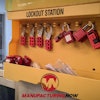ADP Reports Fall in Manufacturing Employment in August
Automated Data Processing (ADP) reported this morning that manufacturing employment fell by 4,000 workers in August, following the loss of 2,000 jobs in July. Overall, total nonfarm employment rose by 91,000, mostly from small- and medium-sized service providers. The goods-producing sector increased employment by 11,000, suggesting that there were gains outside of manufacturing in the construction and mining sectors.
These numbers correspond with several regional indicators of manufacturing activity, which have shown either a slowdown in growth or a contraction in production and new orders, depending on the survey. New employment intentions have fallen in tandem.
Mirroring those other regional studies, the ISM-Chicago Business Barometer declined from 58.8 in July to 56.5 in August. While this figure represents growth in the sector – particularly with the barometer in positive territory for the 23rd consecutive month – it also reflects a slowdown in overall manufacturing activity in the Chicago region. The index was 74.2 in March, for instance. Measures of production, new orders and inventories declined, as well. Employment intentions edged slightly higher, but remains much lower than earlier this year.
With the Institute for Supply Management purchasing number out tomorrow and official employment numbers for August due on Friday from the Bureau of Labor Statistics, we should expect to see more of the same story. Production activity has been slowing down of late, and this has impacted manufacturing employment. While many manufacturers anticipate activity picking up in the coming months (and hence, they will need additional workers), that will materialize, if it does, on subsequent reports.
Chad Moutray is chief economist, National Association of Manufacturers.
SOURCE






















